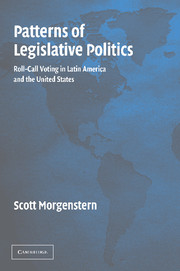Book contents
- Frontmatter
- Contents
- Tables and Figures
- Preface and Acknowledgments
- Party, Faction, and Coalition Names and Abbreviations
- 1 Patterns of Legislative Politics: Identifiability and Flexibility
- 2 Representation and the Agent System
- 3 Identifying Agents
- 4 Influences on Agent Unity: Discipline and Cohesion
- 5 Explaining Voting Unity
- 6 Policy Coalitions and Agent Flexibility
- 7 Conclusion
- Bibliography
- Subject Index
- Author Index
Preface and Acknowledgments
Published online by Cambridge University Press: 24 July 2009
- Frontmatter
- Contents
- Tables and Figures
- Preface and Acknowledgments
- Party, Faction, and Coalition Names and Abbreviations
- 1 Patterns of Legislative Politics: Identifiability and Flexibility
- 2 Representation and the Agent System
- 3 Identifying Agents
- 4 Influences on Agent Unity: Discipline and Cohesion
- 5 Explaining Voting Unity
- 6 Policy Coalitions and Agent Flexibility
- 7 Conclusion
- Bibliography
- Subject Index
- Author Index
Summary
Legislatures house multiple individuals, most of whom are grouped into factions, parties, and coalitions. The patterns of legislative politics, then, are a product of the interactions among group members and among the groups. This book is an exploration of these interactions in Argentina, Brazil, Chile, and Uruguay, using the United States for a point of reference. The four Latin American countries share important commonalities in terms of geography and politics but are also clearly distinguishable for their political histories and institutions. All four countries suffered democratic breakdowns between 1964 and 1973 and only returned to democracy in the 1980s. Since then all have faced important threats to their democracies, ranging from a rising left in Uruguay, the removal of a president in Brazil, Pinochet's move from life-senator to foreign captive and accused murderer in Chile, and Argentina's economic collapse and the resignation of its elected and successor presidents. Though these and other pressures have led the countries to debate and implement important institutional reforms, they have not led to democratic breakdown.
In the past, students of Latin American politics have been forced to focus on the upheavals, military interludes, and democratic transitions. Since democracy seems to have implanted itself, there is a new value and interest in following the traditions of studies of the United States or European democracies and studying how prosaic issues affect legislative dynamics, representation, and coalition formation.
- Type
- Chapter
- Information
- Patterns of Legislative PoliticsRoll-Call Voting in Latin America and the United States, pp. ix - xiiPublisher: Cambridge University PressPrint publication year: 2003



